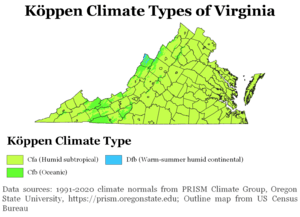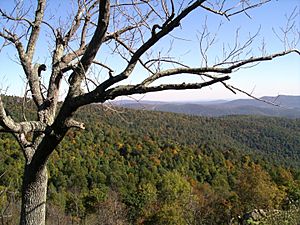Climate of Virginia facts for kids

Virginia is a state on the east coast of the United States. Its climate is generally mild, especially compared to states further north like New England. Most of Virginia, especially east of the Blue Ridge Mountains, has a warm and humid climate. This is called a humid subtropical climate.
In the mountainous areas west of the Blue Ridge, the weather is a bit different. It can be a warm-summer humid continental climate or an oceanic climate. This means summers are warm, but winters can be quite cold with more snow. Virginia also experiences severe weather like tornadoes, tropical cyclones (hurricanes), and big winter storms. For example, in December 2009, parts of central Virginia got about 20 inches (50 cm) of snow!
Contents
Virginia's Climate Zones
Virginia has many different climates because of its varied landscape. The land ranges from sea level along the coast to high mountains like Mount Rogers, which is 5,729 feet (1,746 meters) tall.
The Atlantic Ocean helps keep the eastern part of the state milder. The warm Gulf Stream ocean current can even bring hurricanes near the coast. On the other hand, cold air often moves in from the mountains, especially in winter. This can cause big snowfalls when coastal storms, called "nor'easters," move up the Atlantic coast.
All these different features create unique mini-climates. You might notice slight weather differences in the Shenandoah Valley, the mountainous southwest, and the coastal plains.
Extreme Temperatures in Virginia
Virginia has seen some very hot and very cold temperatures. The hottest temperature ever recorded was 110°F (43°C). This happened at Balcony Falls on July 15, 1954. The coldest temperature ever recorded was −30°F (−34°C). This was at Mountain Lake on January 22, 1985.
Severe Weather in Virginia
Severe weather is something people in Virginia need to be aware of. Hurricanes can be a big worry for the coastal areas. It's rare for a very strong hurricane to hit Virginia directly. This is because hurricanes usually weaken as they move north over cooler ocean waters. However, even weaker hurricanes can bring a lot of rain.
For example, Hurricane Isabel in 2003 caused a lot of damage from wind and rain. It led to 10 deaths and nearly two billion dollars in damage. Hurricane Gaston in 2004 caused major flooding in Richmond. Virginia often gets heavy rain from the leftover parts of storms that hit along the Gulf of Mexico coast. Hurricane Camille was an extreme example. It dropped 27 inches (690 mm) of rain in parts of Nelson County in just a few hours!
Thunderstorms are also common in Virginia. The state usually has thunderstorms on 35 to 45 days each year. While rain is frequent, it doesn't usually cause severe floods.
Virginia also experiences tornadoes. On average, the state has about seven tornadoes each year. Most of these are not very strong. However, in 2004, Virginia had 85 tornadoes! The western part of Virginia tends to have fewer tornadoes.
Seasons in Virginia
Virginia experiences four distinct seasons.
Winter
Winters in Virginia can have big temperature changes, even within the same day. One morning it might be 50°F (10°C) and windy. The next afternoon, it could be 70°F (21°C) and calm. In December, temperatures usually range from the 50s°F (10-15°C) down to the high 20s°F (-7 to -2°C). In January, it can range from the 40s°F (4-9°C) down to the teens°F (-12 to -7°C). Virginia usually gets some snow every winter, especially in January and February.
Summer
Summers are hot and humid. There's also a bit more rain during this season. Temperatures are not usually extreme, staying between the high 70s°F (25-26°C) and mid-90s°F (32-35°C). But the high humidity can make it feel even hotter.
Sunlight
Virginia gets an average amount of sunlight compared to other states. Areas along the Chesapeake Bay and Eastern Shore are usually sunniest. The western and northern parts of the state tend to be cloudier. In winter, Virginia gets about 9 to 10 hours of sunlight each day. In summer, it gets between 14.5 and 15 hours.



